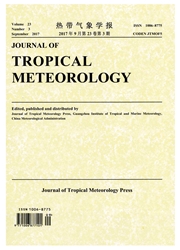

 中文摘要:
中文摘要:
NCEP/NCAR 分析数据被用来在在冬在中国乍见陆地做了的热带气旋(Nanmadol 和 Irma ) 的二个案例的进化期间调查冷空气和潮湿特征的角色。结果如下被显示出。(1 ) 东亚马槽在早冬季驾驶了冷空气进热带海洋。与在圆周的到海和压力坡度的改进的外面的高移动在相反的方向移动的热带气旋在维持并且加强暴风雨的紧张起了一个作用。当他们仍然在温暖的海表面上时,进热带气旋的底层的弱冷空气的侵入由改进气旋的骚乱加强了他们。当冷空气进眼睛足够强壮、侵入时,温暖的核心在驱散前被损坏并且填满。(2 ) 热带气旋在潮湿流动的一个集中地区被形成,他们的发展能提高水蒸汽集中的骚乱,因此加强潮湿集中地区。然而,当他们在潮湿地区外面时,暴风雨不能获得足够的水蒸汽并且变得弱。在热带气旋处理的冬期间没有强壮的潮湿交通的带。
 英文摘要:
英文摘要:
The NCEP/NCAR reanalysis data are used to investigate the role of cold air and moisture characteristics during the evolution of two cases of tropical cyclones (Nanmadol and Irma) which made landfall on China in wintertime. The results are shown as follows. (1) The East Asia trough steered the cold air into the tropical ocean in early winter. The tropical cyclones moved in opposite directions with a high moving out to sea and the enhancement of the pressure gradient at the periphery played a role in maintaining and strengthening the intensity of the storms. The intrusion of weak cold air into the low levels of the tropical cyclones strengthened them by improving the cyclonic disturbance when they were still over the warm sea surface. When the cold air was strong enough and intruded into the eyes, the warm cores were damaged and stuffed before dissipation. (2) The tropical cyclones were formed in a convergence zone of moisture flux and their development could enhance the disturbance of water vapor convergence, thus strengthening the moisture convergence zone. However, when they were outside the moisture zone, the storms could not gain sufficient water vapor and became weak. There were no belts of strong moisture transportation during the wintertime tropical cyclone processes.
 同期刊论文项目
同期刊论文项目
 同项目期刊论文
同项目期刊论文
 期刊信息
期刊信息
